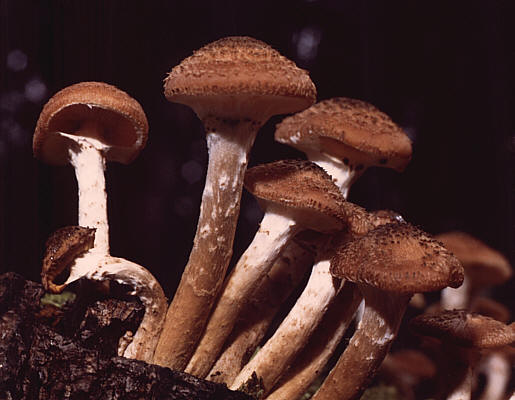
Armillaria ostoyae is a fungus commonly known as a Honey mushroom, and sometimes called Shoestring Rot.
This is the most common variant in the western U.S., of the group of species that all used to share the name Armillaria mellea. Armillaria ostoyae is quite common on both hardwood and conifer wood in forests west of the Cascade crest. The mycelium attacks the sapwood and is able to travel great distances under the bark or between trees in the form of black rhizomorphs ("shoestrings").
The disease is of particular interest to forest managers, as the species is highly pathogenic to a number of commercial softwoods, notably Douglas-fir (Pseudotsuga menziesii), true firs (Abies spp.) and Western Hemlock (Tsuga heterophylla). A commonly prescribed treatment is the clearcutting of an infected stand followed by planting with more resistant species such as Western redcedar (thuja plicata) or deciduous seedlings. The removal of stumps (stumping) has been used to prevent contact between infected stumps and newer growth resulting in lower infection rates. However, it is unknown if the lower infection rates will persist as roots of young trees extend closer to the original inoculum from the preceding stand. The use of another fungus, Hypholoma fasciculare has been shown in early experiments to competitively exclude Armillaria ostoyae in both field and laboratory conditions, but further experimentation is required to establish the efficacy of this treatment.
A mushroom of this type in the Malheur National Forest in the Strawberry Mountains of eastern Oregon, U.S. was found to be the largest fungal colony in the world, spanning 8.9 km² (2,200 acres) of area. This organism is estimated to be 2,400 years old. The fungus was written about in the April 2003 issue of the Canadian Journal of Forest Research. While an accurate estimate has not been made, the total mass of the colony may be as much as 605 tons. If this colony is considered a single organism, then it is the largest known organism in the world by area, and rivals the aspen grove "Pando" as the known organism with the highest living biomass.
In 1992, a relative of the Strawberry Mountains clone was discovered in southwest Washington state. It covers about 6 km² (1500 acres).
Another "humongous fungus" is a specimen of Armillaria bulbosa found at a site near Crystal Falls, Michigan covers 0.15 km² (37 acres), and was published in Nature.
source:wikipedia
The the smallest organism in the world
Autor:
World News


0 komentarze:
Post a Comment